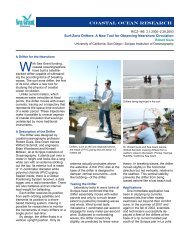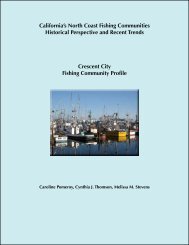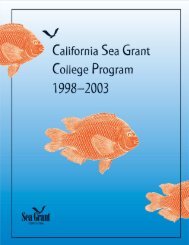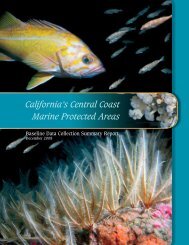2001â2002 - California Sea Grant - UC San Diego
2001â2002 - California Sea Grant - UC San Diego
2001â2002 - California Sea Grant - UC San Diego
Create successful ePaper yourself
Turn your PDF publications into a flip-book with our unique Google optimized e-Paper software.
industry fellow…<br />
NOAA’s National <strong>Sea</strong> <strong>Grant</strong><br />
College Program began the <strong>Sea</strong><br />
<strong>Grant</strong> Industry Fellows Program in 1995.<br />
Through a national competition, the<br />
program provides support for graduate<br />
students pursuing research and development<br />
projects on topics of interest to a<br />
particular industry or company and<br />
requires matching funds from the private<br />
industrial sponsors.<br />
<strong>Sea</strong> <strong>Grant</strong> Industry Fellow Christopher Stevenson worked for<br />
GlaxoSmithKline in Philadelphia, developing a new anti-inflammatory<br />
drug isolated from blue-green algae. Photo: <strong>UC</strong> <strong>San</strong>ta Barbara<br />
<strong>California</strong> <strong>Sea</strong> <strong>Grant</strong> Industry Fellow Christopher Stevenson worked<br />
at a laboratory at GlaxoSmithKline in Philadelphia, studying the<br />
biomedical properties of scytonemin, a pigment molecule found in bluegreen<br />
algae, one of the most primitive photosynthetic organisms on Earth. During<br />
his tenure, Stevenson consulted with his thesis advisor, Robert Jacobs, a pharmacologist<br />
and <strong>Sea</strong> <strong>Grant</strong> researcher at the University of <strong>California</strong>, <strong>San</strong>ta Barbara,<br />
who was the first to discover the pigment’s bioactivity. Stevenson also worked<br />
closely with company researchers.<br />
“We got together with the common goal of using this marine natural product as<br />
an inhibitor of enzymes important in cell proliferation,” said Lisa Marshall, a<br />
project director in the oncology department at GlaxoSmithKline. “The idea was: if<br />
we could inhibit cell proliferation, scytonemin could potentially be an interesting<br />
new medicine.”<br />
Through his experiments, Stevenson was the first to show that scytonemin<br />
inhibits aberrant cell division. He was later able to demonstrate that scytonemin<br />
also reduces skin irritations. Stevenson’s effort lays the groundwork for an exciting<br />
new class of medicines for treating skin inflammation, or potentially any disease<br />
that involves aberrant cell division.<br />
Stevenson was awarded a<br />
Young Investigator Award at the<br />
International Association of<br />
Inflammation Society’s conference<br />
in Edinburgh, Scotland, in<br />
September 2001, and second<br />
prize at the Inflammation<br />
Research Association’s national<br />
conference in October 2002.<br />
Stevenson completed his<br />
doctoral degree in pharmacology<br />
from the University of <strong>California</strong>,<br />
<strong>San</strong>ta Barbara in 2002 and<br />
is a postdoc at Novartis in<br />
England.<br />
“I was in an industry setting where<br />
there were enormous resources.<br />
People were always available for<br />
questions and happy to help overcome<br />
any problems I encountered<br />
along the way. I now have a better<br />
understanding of what is expected of<br />
researchers at industrial scientific<br />
institutions.”<br />
—Christopher Stevenson<br />
44











